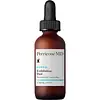What's inside
What's inside
 Key Ingredients
Key Ingredients

 Benefits
Benefits

 Concerns
Concerns

 Ingredients Side-by-side
Ingredients Side-by-side

Water
Skin ConditioningCarnitine
CleansingUrea
BufferingMaltodextrin
AbsorbentPhosphatidylcholine
EmulsifyingDimethyl Mea
BufferingGluconolactone
Skin ConditioningXanthan Gum
EmulsifyingHyaluronic Acid
HumectantMagnolia Grandiflora Bark Extract
AntimicrobialPterocarpus Marsupium Bark Extract
Aloe Barbadensis Leaf Juice
Skin ConditioningZinc Gluconate
Skin ConditioningMagnesium Aspartate
Skin ConditioningChondrus Crispus Extract
Skin ConditioningProtease
ExfoliatingSodium Carboxymethyl Beta-Glucan
CleansingCopper Gluconate
Skin ConditioningDisodium EDTA
Citric Acid
BufferingCaprylyl Glycol
EmollientPEG-7 Glyceryl Cocoate
EmulsifyingPhenoxyethanol
PreservativeSorbic Acid
PreservativeMenthyl Lactate
MaskingCI 42090
Cosmetic ColorantWater, Carnitine, Urea, Maltodextrin, Phosphatidylcholine, Dimethyl Mea, Gluconolactone, Xanthan Gum, Hyaluronic Acid, Magnolia Grandiflora Bark Extract, Pterocarpus Marsupium Bark Extract, Aloe Barbadensis Leaf Juice, Zinc Gluconate, Magnesium Aspartate, Chondrus Crispus Extract, Protease, Sodium Carboxymethyl Beta-Glucan, Copper Gluconate, Disodium EDTA, Citric Acid, Caprylyl Glycol, PEG-7 Glyceryl Cocoate, Phenoxyethanol, Sorbic Acid, Menthyl Lactate, CI 42090
Water
Skin ConditioningDimethicone
EmollientHamamelis Virginiana Water
AstringentPentylene Glycol
Skin ConditioningGlycerin
HumectantCaprylic/Capric Triglyceride
MaskingPropanediol
SolventButyl Avocadate
Skin ConditioningButylene Glycol
HumectantGlycolic Acid
BufferingRetinyl Propionate
Skin ConditioningAllantoin
Skin ConditioningZinc Gluconate
Skin ConditioningMelia Azadirachta Leaf Extract
Skin ConditioningRosa Canina Fruit Extract
AstringentMelia Azadirachta Flower Extract
Skin ConditioningCorallina Officinalis Extract
Skin ConditioningUrea
BufferingYeast Amino Acids
HumectantCoccinia Indica Fruit Extract
Skin ConditioningHelianthus Annuus Seed Oil
EmollientSolanum Melongena Fruit Extract
Skin ConditioningAloe Barbadensis Flower Extract
EmollientSimmondsia Chinensis Seed Oil
EmollientCurcuma Longa Root Extract
MaskingOcimum Basilicum Flower/Leaf Extract
TonicOcimum Sanctum Leaf Extract
Skin ConditioningBHT
AntioxidantBetaine
HumectantInositol
HumectantTaurine
BufferingTrehalose
HumectantTocopherol
AntioxidantSalicylic Acid
MaskingBenzoic Acid
MaskingLimonene
PerfumingLinalool
PerfumingCitronellol
PerfumingGeraniol
PerfumingBenzyl Benzoate
AntimicrobialCitral
PerfumingParfum
MaskingPotassium Sorbate
PreservativeDisodium EDTA
Sodium Hydroxide
BufferingPhenoxyethanol
PreservativeWater, Dimethicone, Hamamelis Virginiana Water, Pentylene Glycol, Glycerin, Caprylic/Capric Triglyceride, Propanediol, Butyl Avocadate, Butylene Glycol, Glycolic Acid, Retinyl Propionate, Allantoin, Zinc Gluconate, Melia Azadirachta Leaf Extract, Rosa Canina Fruit Extract, Melia Azadirachta Flower Extract, Corallina Officinalis Extract, Urea, Yeast Amino Acids, Coccinia Indica Fruit Extract, Helianthus Annuus Seed Oil, Solanum Melongena Fruit Extract, Aloe Barbadensis Flower Extract, Simmondsia Chinensis Seed Oil, Curcuma Longa Root Extract, Ocimum Basilicum Flower/Leaf Extract, Ocimum Sanctum Leaf Extract, BHT, Betaine, Inositol, Taurine, Trehalose, Tocopherol, Salicylic Acid, Benzoic Acid, Limonene, Linalool, Citronellol, Geraniol, Benzyl Benzoate, Citral, Parfum, Potassium Sorbate, Disodium EDTA, Sodium Hydroxide, Phenoxyethanol
Alternatives
Ingredients Explained
These ingredients are found in both products.
Ingredients higher up in an ingredient list are typically present in a larger amount.
Disodium EDTA plays a role in making products more stable by aiding other preservatives.
It is a chelating agent, meaning it neutralizes metal ions that may be found in a product.
Disodium EDTA is a salt of edetic acid and is found to be safe in cosmetic ingredients.
Learn more about Disodium EDTAPhenoxyethanol is a preservative that has germicide, antimicrobial, and aromatic properties. Studies show that phenoxyethanol can prevent microbial growth. By itself, it has a scent that is similar to that of a rose.
It's often used in formulations along with Caprylyl Glycol to preserve the shelf life of products.
Urea is also called carbamide and is the diamide of carbonic acid. In cosmetics, urea is used to hydrate the skin. It also provides exfoliation in higher concentrations.
As a humectant, urea helps draw moisture from the air and from deep within the skin. This helps hydrate your skin. Studies show urea is an effective moisturizer for dry skin conditions. 40% urea is typical in medications for treating eczema and other skin conditions.
Urea has the strongest exfoliation effect in concentrations higher than 10%. It is a keratolytic agent, meaning it breaks down the keratin protein in the top layer of skin. This helps remove dead skin cells and flaking skin.
In medicine, urea has been shown to help increase the potency of other ingredients, such as fungal treatments.
Humans and animals use urea to metabolize nitrogen-containing compounds. Urea is highly soluble in water. Once dissolved, it is neither acidic nor alkaline.
Learn more about UreaWater. It's the most common cosmetic ingredient of all. You'll usually see it at the top of ingredient lists, meaning that it makes up the largest part of the product.
So why is it so popular? Water most often acts as a solvent - this means that it helps dissolve other ingredients into the formulation.
You'll also recognize water as that liquid we all need to stay alive. If you see this, drink a glass of water. Stay hydrated!
Learn more about WaterZinc gluconate has antibacterial and wound healing properties. It is particularly effective against fighting inflammatory acne.
This ingredient is the zinc salt of the PHA gluconic acid. PHAs are gentle cousins to AHAs.